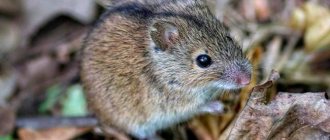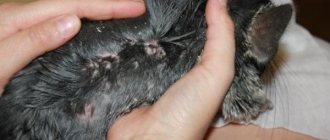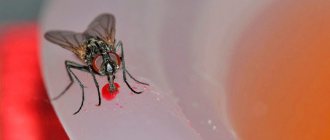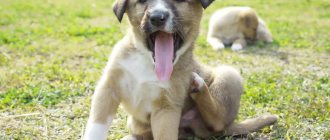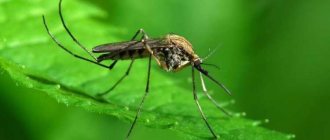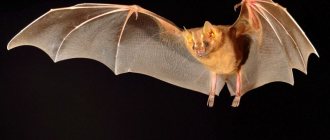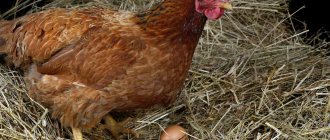Beginning chinchilla breeders are interested in many questions: the behavior of chinchillas at home, their personality traits, and much more. From this article you can learn about your pet’s “bad habits”: do chinchillas bite, how do they sleep, why do they eat their feces, why do they grind their teeth and other interesting facts. It also contains tips for raising chinchillas.
Chinchilla teeth are very sharp
Why do chinchillas bite?
How biting depends on character
The chinchilla bites as a sign of protest when the interests of the pet and the owner collide. This situation can occur if a stubborn animal persistently performs any actions that cause inconvenience to the owner (gnaws furniture, makes a lot of noise) or does not want to play, and the breeder insists on his own.
Chinchilla bites
Some touchy chinchillas show their displeasure by biting. If the owner deprives the animal of a walk or leaves home for several days, the chinchilla will be demonstratively offended - refuse the treat, and not pay attention to the offender. To be bitten, you just have to pick up a rodent in this state of mind.
A timid animal that is afraid of its owner can bite him repeatedly during taming. And the overly sociable person shows sympathy by lightly biting the hands of his household members.
A chinchilla can bite simply out of harm. Animals also have this character trait.
If a breeder wants to find a calm pet that does not show aggression and does not use its teeth, then before purchasing it is worth observing the animal or asking the farmer what type of temperament the individual being purchased belongs to. Chinchillas show their character from childhood, so an easily excitable choleric person or an active sanguine person can be easily distinguished from a calm phlegmatic person and a timid melancholic person.
Aggression
As mentioned earlier, sometimes when rodents get scared or defensive, they will attack. This happens most often with new ones. Bites are usually preceded by squeals, barks, screams, and screams. It may also be preceded by standing on its hind legs, so they appear larger or more vicious than they actually are. When you notice any of these actions, be sure to leave it alone until it cools down.
Find out more Why does a rabbit bite and what to do
Pay attention to where the safe areas are, and do your best not to drive them away from those areas. Besides, let her come to you. They respond to names.
It takes some time (sometimes a year) before the pet gets comfortable. This is especially true for abused chinchillas that have not been properly socialized by breeders. If you know the rodent hasn't had the easiest life, make sure to socialize it very slowly and don't try to touch it for a few weeks.
Let them get used to the new environment, try not to move quickly, make loud sounds, or spray scents around.
Chinchilla bites can be quite serious and may require stitches. If you are bitten, disinfect the wound, apply an antibiotic, and if the bleeding does not stop, consult a doctor.
Reasons why a chinchilla may bite
- Studying the owner. To understand what a particular object is, a chinchilla needs to taste it. This is the nature of rodents, especially for babies.
- Accident. The animal may bite a piece of skin or the owner's finger along with a treat or a sweater sleeve.
- Discontent. Do not disturb the chinchilla while resting or force it to do anything. An irritated animal may bite the offender's finger or other accessible parts of the body. This reaction can occur when another rodent is introduced into the pet’s cage.
- Aggression. If you don’t immediately begin taming your pet, then any intrusion into its territory to pour food or remove garbage will be accompanied by an attack on the “enemy.”
- Revenge. An animal can deliberately bite its owner if he offended him, did not feed him, or does not care for him well.
- Mating season. Overexcited pets may behave inappropriately while protecting their significant other.
Routes of infection
All warm-blooded animals on earth are susceptible to attacks by parasites such as fleas. Chinchillas are no exception. Even if the animal spends all its time in the apartment, this does not mean that it is protected from the pest. Fleas can appear in chinchillas for the following reasons:
It is enough to have other pets in the house. One of the most common ways to infect a furry creature is to have a dog or cat in the house that regularly leaves the house. A person can also bring fleas into the house on outer clothing or shoes. It’s not for nothing that fleas are called jumping champions, since in search of their prey they are able to cover very long distances in a very short time. The most favorite habitats for fleas are basements and attics, from which insects can enter the house through the ventilation shaft. We should also not exclude the possibility that the chinchilla got fleas while at the pet store.
Therefore, when buying an animal, you should pay attention to this nuance. Another source of infection for a furry rodent is hay, which is most often sold in pet stores or poultry markets. When placing an animal’s favorite treat in a cage, it is necessary to carefully inspect it.
Biting or biting
Chinchilla biting is accompanied by other signs of aggression:
- growling or barking;
- deep dents on the hand;
- sudden movements.
Playful biting goes like this:
- no sounds;
- without pain;
- accompanied by sniffing and playing with fingers.
Let go of your tail or I'll bite you
Affectionate biting is accompanied by other signs of sympathy:
- sniffing;
- "massage";
- can lick with tongue;
- closing your eyes with pleasure;
- puts up its muzzle to be stroked.
How to stop a chinchilla from biting
In most cases, it is enough to take good care of your pet, do not force him to do anything and do not disturb him while he is resting. But first, the animal needs to be tamed:
- more communication;
- give treats from your hands;
- do not bother, do not force games;
- do not go against the will of the pet;
- You shouldn’t grab the animal, let it come into your palm on its own.
To stop a chinchilla from biting, you can use several tricks from experienced chinchilla breeders:
- Move your pet away slightly after the bite and tell him that you can’t do that.
- Lightly click the animal on the nose.
- After a bite, you should not give the rodent a treat.
What to do after a bite?
Light chinchilla bites are safe.
These animals rarely become carriers of dangerous diseases.
If your pet is bitten until it bleeds, you need to treat the wound with hydrogen peroxide or another disinfectant, stop the bleeding and cover the damaged area with a band-aid. When the bite does not last for a long time, becomes inflamed, festeres and hurts, a person should seek help from a medical facility. In this case, the doctor prescribes tests, the results of which determine further treatment.
Other “bad” habits
Most chinchilla habits have a natural origin. Why does a chinchilla eat its own excrement and jump? Because it is so inherent in nature. The structure of their legs is designed for jumping and protection from predators, and due to the droppings, the intestinal activity of the animals is improved.
Falls over on its side
It is rare, but it happens that a chinchilla sleeps on its side simply because this is its favorite comfortable sleeping position.
There are other relatively harmless causes of such “fainting”:
- pregnancy;
- exhaustion and exhaustion;
- overheat.
We sleep as we want!
Rolling onto one side should be a cause for concern if it is accompanied by other symptoms of various pathologies:
- Stroke – aggression, inappropriate behavior, severe thirst, decreased appetite.
- Diseases of the cerebellum - vomiting, decreased chewing function, strabismus, no appetite.
- Rabies - when the animal falls on its side, it twitches.
If your chinchilla has not slept in this position before and if suspicious symptoms appear, you should immediately contact a veterinarian.
Grits his teeth
There can be many reasons for teeth grinding. Most often, the pet simply grinds down its teeth. If, in addition to the fact that the chinchilla grinds its teeth, nothing strange is observed in its behavior, then there is no reason for concern. If you suspect your animal is unwell, it is better to contact a veterinarian.
When the grinding is accompanied by a lack of appetite, it is necessary to check the health of the pet - perhaps he was poisoned by table salt, chemicals or a poisonous plant. In case of poisoning, the following are also observed:
- diarrhea;
- dilated pupils;
- paralysis;
- excessive salivation;
- thirst;
- blue mucous membranes.
Gnaws the cage
- Reasons why a chinchilla chews its cage and how to eliminate them:
- Boredom. It is necessary to give the animal walks, add toys and crawl spaces.
- Natural necessity. Sometimes it is enough to simply place other dental simulators in the cage - tree branches, mineral stones, wooden toys.
- Defensive reaction. If a chinchilla sheds its fur and chews on its cage, it means it wants to free itself. To make your pet friendly, you need to use various taming methods.
When choosing a cage, you must immediately ensure that your pet can chew on it. A cage made of hard wood (beech, etc.) is ideal.
Let me out of here! I want to go for a walk!
Diseases of the gastrointestinal tract
Diarrhea
Symptoms
- Frequent passing of stool.
- Bloating.
- Strong excitement.
Treatment
A solution of water with Ftazol or charcoal in a ratio of 1:3. Drip 5 ml from a syringe without a needle directly into the mouth 4-6 times a day. Give tea from marsh wild rosemary and calamus.
Prevention
- Clean, fresh water
- Treating the cage against mold.
How often do you change the water in your sippy cup?
Constipation
Symptoms
- Chinchilla sits hunched over in the corner
- No bowel movements for several days
- The abdomen is enlarged and hard
Treatment
- Drink plenty of fluids
- Juicy food: fruits, greens.
- Solution: 3 drops of regulax, 1 ml of castor oil and 100 g of water. The laxative should be given using a dropper.
Prevention
- Less concentrated feed
- Large amount of water
- Ensuring high mobility
- Elimination of stress, noise and shock.
Bloating
Symptoms
- Inflated hard belly
- "Drumming" sound when tapped
- Low mobility
- Tries to sit as low as possible
Treatment
Carminative agent Espumisan L (emulsion) or SAB Simplex from a human pharmacy, 1 ml. To begin with, drink every 4 hours and at least 2 times a day. Espumisan collapses gas bubbles in the intestines. Massage the abdomen in a circular motion.
Prevention
- Dry food without vegetables and fruits, they can cause fermentation and bloating.
- Fresh food.
- Abdominal massages.
Rectal prolapse
Symptoms
Partial or complete inversion of the rectum outward
Treatment
- Wash the damaged area
- Don't feed
- Inject a painkiller
- Go to the doctor urgently
At the hospital, the prolapsed intestine will be put back in place. Lubricate the damaged area with a 1% solution of potassium permanganate and 5% novocaine ointment.
Prevention
Treat and monitor the condition of the animal in a timely manner. Avoid factors that contribute to the disease, such as frequent constipation, diarrhea, the use of enemas, and colds.
Gastroenteritis
Symptoms
- Lethargy
- No appetite
- Shyness
- Diarrhea
Treatment
Diet. Fresh hay, oats, carrots, rosehip tea.
Prevention
- Do not change food suddenly
- Give fresh hay, without mold
- Keep the water clean
Chinchillas can even get pneumonia
How to put a chinchilla in a cage
Many chinchilla breeders are faced with this problem - the animal does not want to return to the cage after a walk. This may come from mischief or the chinchilla simply does not like her home, perhaps she is lonely and bored there.
Here are several ways to herd the animal into the house:
- Buy or make the cage more spacious and comfortable, add toys, buy a second chinchilla.
- Wait until the chinchilla has walked up and wants to return to the house.
- Training. Command "Home!" and good!" must be combined.
- Do not feed a couple of hours before a walk, but lure him with food after the walk.
